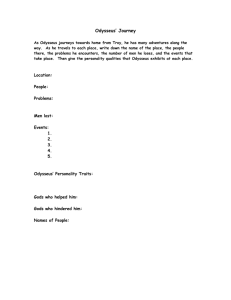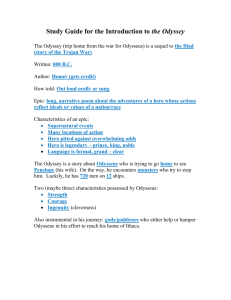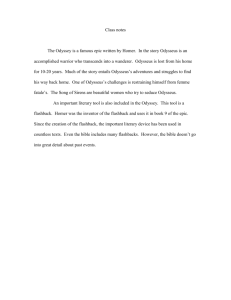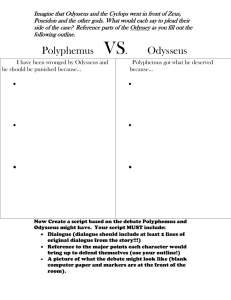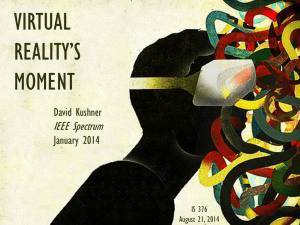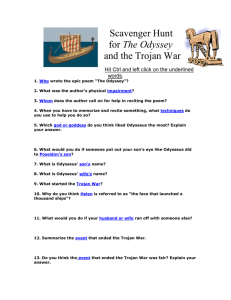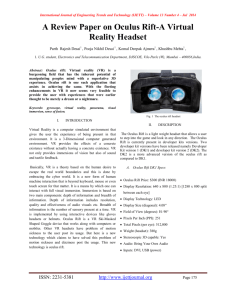“ODYSSEUS IN THE OCULUS RIFT”: A TEAM TEACHING
advertisement
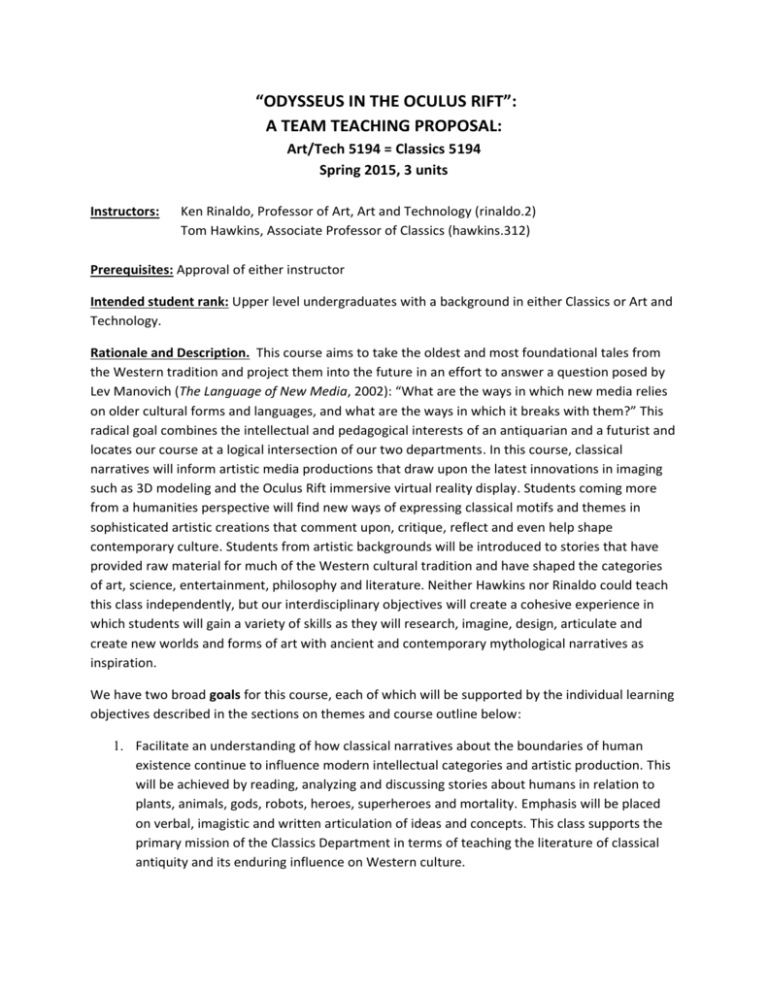
“ODYSSEUS IN THE OCULUS RIFT”: A TEAM TEACHING PROPOSAL: Art/Tech 5194 = Classics 5194 Spring 2015, 3 units Instructors: Ken Rinaldo, Professor of Art, Art and Technology (rinaldo.2) Tom Hawkins, Associate Professor of Classics (hawkins.312) Prerequisites: Approval of either instructor Intended student rank: Upper level undergraduates with a background in either Classics or Art and Technology. Rationale and Description. This course aims to take the oldest and most foundational tales from the Western tradition and project them into the future in an effort to answer a question posed by Lev Manovich (The Language of New Media, 2002): “What are the ways in which new media relies on older cultural forms and languages, and what are the ways in which it breaks with them?” This radical goal combines the intellectual and pedagogical interests of an antiquarian and a futurist and locates our course at a logical intersection of our two departments. In this course, classical narratives will inform artistic media productions that draw upon the latest innovations in imaging such as 3D modeling and the Oculus Rift immersive virtual reality display. Students coming more from a humanities perspective will find new ways of expressing classical motifs and themes in sophisticated artistic creations that comment upon, critique, reflect and even help shape contemporary culture. Students from artistic backgrounds will be introduced to stories that have provided raw material for much of the Western cultural tradition and have shaped the categories of art, science, entertainment, philosophy and literature. Neither Hawkins nor Rinaldo could teach this class independently, but our interdisciplinary objectives will create a cohesive experience in which students will gain a variety of skills as they will research, imagine, design, articulate and create new worlds and forms of art with ancient and contemporary mythological narratives as inspiration. We have two broad goals for this course, each of which will be supported by the individual learning objectives described in the sections on themes and course outline below: 1. Facilitate an understanding of how classical narratives about the boundaries of human existence continue to influence modern intellectual categories and artistic production. This will be achieved by reading, analyzing and discussing stories about humans in relation to plants, animals, gods, robots, heroes, superheroes and mortality. Emphasis will be placed on verbal, imagistic and written articulation of ideas and concepts. This class supports the primary mission of the Classics Department in terms of teaching the literature of classical antiquity and its enduring influence on Western culture. 2. Support students working in teams and as individuals to conceptualize, design and create expressions of future narratives based on an awareness of the human/animal/machine in a variety of story worlds. Promote and support new media technologies, such as 3-D modeling, animation, game engines and virtual reality (including the Oculus Rift) to find new ways of remixing classical narratives in art. The skillsets and projects associated with this dimension of the class address the core goals of the Art and Technology Program within the Department of Art. In order to move toward these goals, evaluation will take many forms, and Hawkins and Rinaldo will share duties at every point. Basic evaluation of narrative competence, for example, will take the form of quizzes and the ability to speak articulately to the themes and issues of given assignments; and technical objectives will be assessed with frequent project deadlines and both faculty and group feedback on student work. The largest portion of students’ grades will be determined by individual and group projects in which students will develop complex works of writing / art that combine the conceptual, theoretical and material aspects of what is offered in this course. These projects will be flexibly articulated to correspond to students’ interests and skill-sets and each will combine written/discursive and creative/performative elements that draw upon our study of ancient narratives and new media techniques. We envision three such projects, the first involving verbal and visual sketches of imagined worlds, the second using some form of 3D imaging to create a world, and the third being a larger, more open-ended expression of students’ own goals for this material. We plan to encourage group work at every stage, both as a way to harness individual strengths and to produce more complex and carefully articulated final products. We hope that some students will use their final projects as stepping stones toward future work (artist portfolios, business ventures, senior theses, etc.) In terms of pedagogy, Rinaldo and Hawkins will work together on every session of this course to ensure that each assignment and activity addresses the overarching goals of the course in a unified way. Given the radical nature of our plan to marry classical antiquity to the latest innovations in art and technology, this basic pedagogical statement will take shape in a variety of ways. For some sessions one instructor will take the lead, while the other will provide contextualizing support to show how the main themes of the day speak to his discipline. In some cases we will split the class according to enrollment (Classics or Art and Tech) so that Rinaldo can give advanced technical instruction to students from his department and Hawkins can do the same to students from his. But this split will also be reversed so that Rinaldo can assist Classics students in getting up to speed with the basics of our technology, while Hawkins will help the Art and Tech students understand more deeply the importance of narrative. Themes: 1. Storytelling. How are stories conveyed to an audience? Who gets to tell them? When is it appropriate to tell a story? What are the technical issues that underpin the telling of a story? Examples include Homer, Demodocus (a bard in the Odyssey), Odysseus (who tells much of his own tale in the Odyssey), Athenian citizen playwrights and actors. How do modern technologies facilitate or impede the telling of stories? Examples include books, video, and visualizations from the most abstract and metaphorical to highly accurate 3D visualizations to virtual reality. In various forms of media sound, image, performance and interactivity can come together to create levels of emersion formerly only known in the realm of dreams. 2. Humans, monsters, hybrids. Why do we enjoy stories about human, monsters and hybrids? How do they work as metaphors for social issues or for understanding human history in the cosmos? Examples come from Odysseus’ adventures with the Cyclops, a witch who turns his men into pigs, and man-eating giants, but also from Euripides’ tale of the plight of women in the aftermath of war (Trojan Women). The Day of the Triphids and “Godzilla” provide modern examples of monsters that result from genetic mutations. Artists like Stelarc and Orlan epitomize the modern cyborg and hybridity. In his work The Third Hand, Stelarc uses abdominal and leg muscles to control a robotic third hand and write EVOL, and uses his two other hands to complete the word EVOLUTION. Contemporary movies like “Splice” compel and horrify when genetic and scientific protocols run afoul. 3. Humans, gods and superheroes. Whereas monsters and hybrids tend to be bad, gods, heroes and superheroes offer typically more positive models of creatures who are more powerful than humans. In what ways are such creatures themselves monstrous? What is the relationship between these more positive (often ambivalent) figures and monsters? Examples will include the relationship between Odysseus and Athena (and also Calypso and other divinities). We will also investigate the connection between classical heroic patterns and modern comic book superheroes. Artists such like Mike Kelly and his Exploded Fortress of Solitude 2011, in which sculptural depictions of Superman’s birthplace in Kandor, conflate various media techniques such as glass, animation and character to address contemporary themes about power. CW Marshall (co-editor of Classics and Comics) will be at OSU in the spring and may be available to speak to our class. 4. Humans and other animals. Monsters and superheroes can easily be labeled as fictional or fanciful creatures, but animals share our world in real terms. Are humans animals? If not, what are we? If so, how are we different from our fellow animals? Is the boundary between us sharp or fuzzy? How has this deeply philosophical question changed in light of recent technological advances (e.g. decoding the genome, organ transplants, the study of animal language)? Are humans and other animals optimized toward the extreme? To address some of these questions we will focus on contemporary ways of knowing the animal. Scientific studies using fMRI and looking at human and birdbrains and the language center in both. Contemporary imaging research in seagulls, dolphins, chickens, cuttlefish, will help form and question the ways we have come to know animals. Artworks using rat neurons to drive robots will serve as models for thinking about decoding and communication in the world of data collection and data analytics. Within the literary realm we will assess stories by and about Aesop (an ugly and mute slave who told fables), Socrates (who looked like a satyr and claimed the dog was the ideal philosopher), and Diogenes (who acted like a dog and was the first Cynic, aka dogphilosopher); Aristophanes’ Birds presents a fanciful comedy in which two humans become birds and create a utopia in the air that interrupts the sacrificial economy between humans and gods; and Philip K. Dick’s Do Androids Dream of Electric Sheep? presents a world in which humans are tightly hemmed in by their thoughts about both animals and ‘replicants’, technologized humanoids. 5. Humans, clay and silicon. Rich Gold (1950-2003) of Xerox Park is quoted as saying: “Artists have always made art with the mud and water at the river’s edge, though now the river is information and the mud has become silicon.” Some of our earliest tales show humans emerging from the earth. This mineral connection is now reworked in the myriad opportunities for synthetic interactions with humans – all of which rely on the manipulation of mineral-based materials. Can technology be part of the story of human evolution? Films such as “HER” engage the new notion of Artificial intelligence, though actual expert systems like Watson have already won games such as Jeopardy and military animals from General Dynamics, like the Big Dog or Google’s own SHAFT bipedal robots combined with expert systems, allow us to know we are on the cusp of artificially intelligent robots. Classical examples come from Genesis, stories of Pandora and the brothers Prometheus and Epimetheus. Isaac Asimov takes us into the future with “Robot Dreams” (about robot who dreams he’s a person) and “Strikebreaker” (about one planet’s strict taboo surrounding human waste. COURSE OUTLINE Designed for a 14 week term with two sessions per week. Assignments and activities for each week are scheduled to optimize conflation of curricular areas of exploration. We are looking forward to receiving the unexpected. Week 1: Introduction. The Cyclops scene from the Odyssey, Asimov’s “Robot Dreams” and works by Johnathon Monaghan and Guy Ben Ary / Symbiotica will be used to give a broad introduction to the themes and goals of our course in terms of exploring the limits and parameters of the human animal. Software / 3D (tech focus): Review of software interface, using viewports, translating and moving objects in the viewport, the attribute manager, the object manager, adjusting renders settings, primitive objects, grouping objects. Week 2: Other than human. Read Odyssey 1-6; watch Bjork’s “All is Full of Love”, and “Rubber Johnny” by Chris Cunnigham and Aphex Twin. As we watch Odysseus reject immortality and a cyber-Bjork, we can ask where the limits of the human are. What exceeds humanity? Or is that question circular? Software / 3D (tech focus): Parametric primitives and their attributes. Moving objects, scaling objects, rotating objects, selection properties, and simple materials. Objects menu, coordinates menu, attributes menu. Windows, axis, object tool. Brief history of the origins of platonic solids and neolithic people of Scotland. DUE THIS WEEK: Preliminary drawings and writings 3 quick sketches about imagined worlds. These are rough sketches and automatist writings, scribbles, poems and or raps and serve to direct assignment two. Class critique and discussion surrounding your works. Week 3: Beyond here be monsters. Read Odyssey 7-12, investigate the Carnivorous Domestic Entertainment Robots of James Auger and Jimmy Loizeau, visit Rinaldo’s “Fusiform Polyphony” and read Chapter 1 of Rinaldo Interactive Electronics for Artists and Inventors. Odysseus narrates his adventures among witches, the Cyclopes and other monsters. What are monsters? Are they psychological boogies? Evolutionary dead-ends? Metaphors? As we ask these questions we also develop the technical skills to create our own monstrosities. Software / 3D (tech focus): Polygon based modeling continued parametric primitives, fillet, functions>duplicate, array hypernurbs, parent/child organization in objects manager, symmetry objects, materials with transparency and alpha channel and introduction to shaders. DUE THIS WEEK: Based on feedback from your classmates, drawings and writings about imagined worlds. These are refined sketches and automatist writings and serve to direct assignment three. Sign up this week for individual meetings with professors. Week 4: Can humans heal? Read Odyssey 13-18 and watch Joseph Beuys’ shamanistic performance of invented rituals of healing. Odysseus’ return home leads to one of the great conundrums of the epic, namely the question of whether Odysseus is really Odysseus. Disguises, divine interventions, attempts to reconnect with wife and son, war trauma and a touching/pathetic moment with Odysseus’ old hunting dog will frame our discussions. Beuys’ performance installations with a wild coyote intersect provocatively with Odysseus’ attempts to reclaim his home as Beuys works to redefine his story. Software / 3D (tech focus): Render settings. Lighting. Setting the stage for your models. A portion of class will be spent working on project. Deformers: Twist, bend, bulge, shatter, etc. Also continued lessons on Nurbs and their advanced features. Importing models from other sources. Discussions regarding the homework readings. Materials and how to apply. Staging. Lighting continued. Shadows. Ray depth. Rendering and render settings in preparation for critique in class DUE THIS WEEK: Based on feedback from your classmates and professors, 3D models about imagined worlds. These are refined 3D models, which you are to present to the class along with your writings. Begin discussions about individual vs team projects and break into groups. Week 5: Humans and the Mind. Read Odyssey 19-24, watch “Absolute Wilson” and excerpts of Sacks’ The Man who Mistook his Wife for a Hat. Homer’s epic concludes with horrific slaughter and a neural rewiring by the gods – where do such acts leave the human mind? Software / 3D (tech focus): Polygon based modeling continued. Subdivision, cut tool, smooth shift soft selection. Using boolean to hollow out a solid object. Unity game Engine and researching paths from C4D to the Unity game engine. Projects development: From here the class diverges into groups and/or individual projects. We intend to support a multiplicity of approaches given the diverse capabilities the class will afford. We will embrace and celebrate the creative and unexpected. Week 6: Heroes and Superheroes. Watch “Ironman III” and “Man of Steel”; read “Introduction” from Classics and Comics, edited by C.W. Marshall, who will be speaking at the Billy Ireland Cartoon Library and whom we intend to bring to our class for a special session on the relationship between classical heroes and comic book superheroes. Software / 3D (tech focus): a) animating color, b) animating form and shape, c) animating with deformers. Research export paths from Unity Game Engine to the Oculus Rift and work to connect both worlds as test bed to future worlds. DUE THIS WEEK: Your individual and or team plan to complete your projects. Discuss concept development and final projects with clear deadlines and goals for each week outlined. Week 7: Hybrid natures. Read Sophocles’ Women of Trachis and research the video art of Rafael Lozanno Hemmer, Kurt Hentschleger and Ulf Langheinrich. Sophocles’ tragedy tells the story of how Herakles becomes a god at the moment of his excruciating death, orchestrated by a Centaur (hybrid man-horse). We will discuss the basic context and workings of classical drama and contemporary theatrical process and presentation. We will delve into this first play to explore the limits of humanity in close proximity to animals (the equine centaur) and gods (apotheosis). Our readings will help frame discussions of the human mind, prompted in part by analysis of contemporary theatrical process and presentation. Software / 3D (tech focus): Animation of camera and objects along a spline and creating a camera flyaround. Demo of a rail spline for banking of objects in space. Target camera techniques. Introduction to the animation menu and getting to know keyframes. Using particle systems within bounded environments. Reading Assignment. Other ways of getting your data into the Oculus DUE THIS WEEK: Your individual and or team progress toward final project Week 8: The human beast. Read Euripides’ Trojan Women. Our second tragedy deals with what happens to the main female characters at the end of the Trojan War. We will situate this play in its historical context within the Peloponnesian War, and use it as a starting point for considering the bestial potential of humans. Art inspiration will look at the films of Mathew Barney and the Cremaster Cycle and Paul McCarthy’s work with costume and performance. Art making continues working with the Unity engine continued. Continue to test migrate c4d files to Oculus Rift. For those doing animation a fly by of the Hybrid object is due today ready for critique. The works must be colored with shaders and keep your poly counts low. Allow detail where things need to bend for rigging a character that will move or walk. Homework. Unity engine to Oculus rift paths video by Peter Giorkaris (Software Engineer Oculus VR Inc.) Week 9: Humans as/and Animals. Aristophanes’ Birds, Dick’s Do Androids Dream of Electric Sheep? and investigate the works of Patricial Piccinnini that conflate the animal, machine and god. Aristophanes’ comedy about two disaffected Athenians who become birds and create a strange bird-city in the sky provides our most sustained excursion into the relationship between animals and humans (as well as gods). It also will prepare the way for our discussion of fables in Week 12. Software / 3D (tech focus): Discussion of montage and Sergei Eisenstein who defined the concept of dialectical montage in film editing. Animation with Boolean operations. Animation with metaballs. Animation of lights. How to use the region tool to stretch your animations. Working with F-Curves and changing relative speed of objects. Easing in and easing out. DUE THIS WEEK: Your individual and or team progress toward final project Week 10: Anomalous humans. Read excerpts of Plato and stories about Socrates; investigate the works of HR Giger and Kenji Yanobe. Our select readings will focus on Socrates’ body (he’s as ugly as a satyr), Plato’s suggestion that the dog is the ideal philosopher, the tri-partite human soul in terms of internal divisions in the human animal, the ethics of story-telling and Plato’s definition of the human as a ‘featherless biped’. Software / 3D (tech focus): Using depth of field in physical render engine animating Camera and changing focus distance for different cinematography angles and approaches for your animation. Week 11: Humans and the low. Read excerpts on Cynicism and stories about Diogenes; investigate the art of Wim Delvoye that conflates modern and profane in high tech installations. The Cynics take the dog-as-philosopher to an extreme and embrace the idea that the true philosopher, indeed the truly natural human lives like a dog. Software / 3D (tech focus): Lesson on Bodypaint Xpresso and making one object move or react when another moves or reacts Using the IK chain with the spline selection to allow things to move Using the metaball to model any bio based object quickly A rough draft of Software / 3D Your composite or other work is due for review by the class. If animation, sound must be part of this new render output and if a still the test print must be completed printed in a test print and if virtual reality space, all the transfer render files and conversion from c4d Unity - Ocululs Rift must be complete and tested on the Oculus Rift DUE THIS WEEK: Full class critique: Your individual and or team progress toward final project Week 12: Fables. Fables use short and easy narratives to comment on the human world. We will read and discuss various fables, but we will also devote our attention to the biographical tales about Aesop, who combines some of the traits and habits of Socrates and Diogenes. Software / 3D (tech focus): Basic Audio Soundtrack Creation, loops, GarageBand lessons. etc., Keeping it Lean. Week 13: Satire on humanity. Read Lucian of Samosata’s True Histories, a ridiculous romp through parodies of Odysseus and travel tales. It has been called the first sci-fi novel, and we will use its wild and farcical adventures as a point of connection with the satirical bent in contemporary culture. Continue working on your final projects. Week 14: Conclusions. Software / 3D Your final work is due no matter what form it has taken. For occulus rift 3D renders, animations and moving image works are to be complete. For performances, installations, interactive or image based works, all must be ready for display in the Art and Technology Exhibition.
